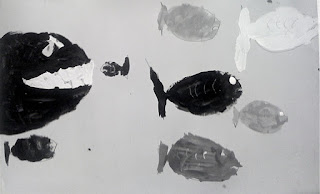 |
| blue tape on the left side of the picture has the students name for identification for upcoming art show. |
Discussion: Form
What is form?
How is it different then a painting?
what is space?
Negative space?
Positive space?
Claire Falkenstein,
Body Centered Cubic
on display at the Crocker Art Museum in Sacramento, CA
Claire Falkenstein (1908-1997)
American artist and sculptor
Through her long and prolific career, Claire explored every medium, from sculpture, drawings and paintings to prints, wallpaper and jewelry.
An Oregon native who worked in Paris, France, the San Francisco Bay area and Venice, California.
Falkenstein is best known for her monumental sculptures as well as her more intimately-scaled prints and jewelry.
Falkenstein experimented endlessly, learning about metals by melting them in spoons over a kitchen stove.
Soon, she was manipulating gold, silver, platinum, brass, copper and steel into necklaces, brooches, rings as well as large-scale sculpture.
Working in Italy in the late 1950's, she made one of her great discoveries, devising a way to virtually "fuse" glass and metal—two very different materials in behavior and chemistry—into single pieces.
This combination of materials became the hallmark of her creative production.
While she was working small, Falkenstein was thinking big.
Gradually abandoning traditional media like wood and clay, she began producing large-scale sculptures, fountains and other structures using innovative glass and metal techniques first explored in her highly experimental jewelry.
SAFETY discussion is necessary for this project. I gave the students 3 feet of wire. If students are too close together someone could get hurt. If you can not spread students out, coil up the wire while children work and remind them at all times to be safe.
Project: create a small wire sculpture with beads
Step1: know that you must be gentle while working with wire
Step2: decide on a shape, our artist used the shape of a square. YOu finished product should be no bigger then your fist
Step3: as you begin to twist and mold your wire into a shape remember your beads
Step4: add in all beads into your sculpture
Step5: add in a small colored wire as your last step
Materials:
Beads
Wire 3 feet, Dick Blick wire for students.
1 Twistezze per child, Dick Blick












































